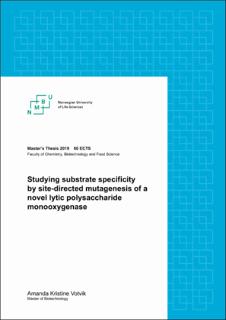| dc.contributor.advisor | Eijsink, Vincent | |
| dc.contributor.advisor | Forsberg, Zarah | |
| dc.contributor.advisor | Stepnov, Anton | |
| dc.contributor.author | Votvik, Amanda Kristine | |
| dc.date.accessioned | 2020-02-18T13:31:29Z | |
| dc.date.available | 2020-02-18T13:31:29Z | |
| dc.date.issued | 2019 | |
| dc.identifier.uri | https://hdl.handle.net/11250/2642336 | |
| dc.description.abstract | Cellulose and chitin are carbon-rich biopolymers which constitute the two largest biomass resources on earth. Conversion of these non-edible and renewable resources into useful products of value is essential to secure a sustainable bioeconomy. However, the efficient processing of cellulose and chitin is hampered by their recalcitrant nature.
To exploit the energy-rich composition of these homopolymers, different microorganisms have evolved specialized enzyme systems which include enzymes referred to as lytic polysaccharide monooxygenases (LPMOs). LPMOs are copper-dependent enzymes, which in the presence of an external electron donor, catalyzes cleavage of the glycosidic linkages in recalcitrant polysaccharides through an oxidative and somewhat enigmatic reaction mechanism. LPMOs display relatively flat substrate binding surfaces which enables them to bind to the planar surface of crystalline polysaccharides. Various structural motifs, of conserved surface exposed residues found on the substrate binding face, are believed to contribute the specific oxidizing activity of LPMOs toward different polysaccharides.
Seven LPMO encoding genes are found within the genome of the Gram-negative soil bacterium Streptomyces coelicolor. Among these LPMOs, various specificities for substrate and regioselectivities have been identified such as C1- or C1/C4-spesific cellulose oxidizing enzymes, and enzymes which display activity both toward cellulose (C1/C4) and chitin (C1). One of these enzymes which have not been characterized yet, called ScLPMO10D, exhibits a catalytic domain with conserved motifs specific for both chitin- and cellulose oxidizing LPMOs. In addition, ScLPMO10D exhibit a C-terminal domain that have been predicted to covalently anchor the catalytic domain to the cell wall, an unusual feature which may classify ScLPMO10D within a novel clade of Auxiliary Activity Family 10 (AA10) enzymes.
In this study, ScLPMO10D was characterized as a chitin oxidizing enzyme with particular specificity toward β-chitin. Taking advantage of its sequence similarity to cellulose-oxidizing
AA10s, five surface-exposed residues were targeted for site-directed mutagenesis in an attempt to change the substrate specificity toward cellulose. Out of the six mutants produced, none displayed activity toward cellulose. However, out of two mutants with retained activity on β- chitin, one displayed an initial rate of catalytic activity which exceeded the wild type enzyme. | en_US |
| dc.description.abstract | Cellulose og kitin er karbonrike biopolymerer som utgjør to av de største biomasse-ressursene på jorden. Enzymatisk omdanning av disse ikke-spiselige og fornybare ressursene, til nyttige produkter av verdi, regnes som et avgjørende steg for å sikre en bærekraftig bioøkonomi. Kostnadseffektiv prosessering av kitin, men aller mest cellulose, er derfor et viktig mål innen industriell bioteknologi; et mål som foreløpig er hindret av deres tungt nedbrytbare oppbygning. | en_US |
| dc.language.iso | eng | en_US |
| dc.publisher | Norwegian University of Life Sciences, Ås | en_US |
| dc.rights | Attribution-NonCommercial-NoDerivatives 4.0 Internasjonal | * |
| dc.rights.uri | http://creativecommons.org/licenses/by-nc-nd/4.0/deed.no | * |
| dc.title | Studying substrate specificity by site-directed mutagenesis of a novel lytic polysaccharide monooxygenase | en_US |
| dc.type | Master thesis | en_US |
| dc.source.pagenumber | 123 | en_US |
| dc.description.localcode | M-BIOTEK | en_US |

